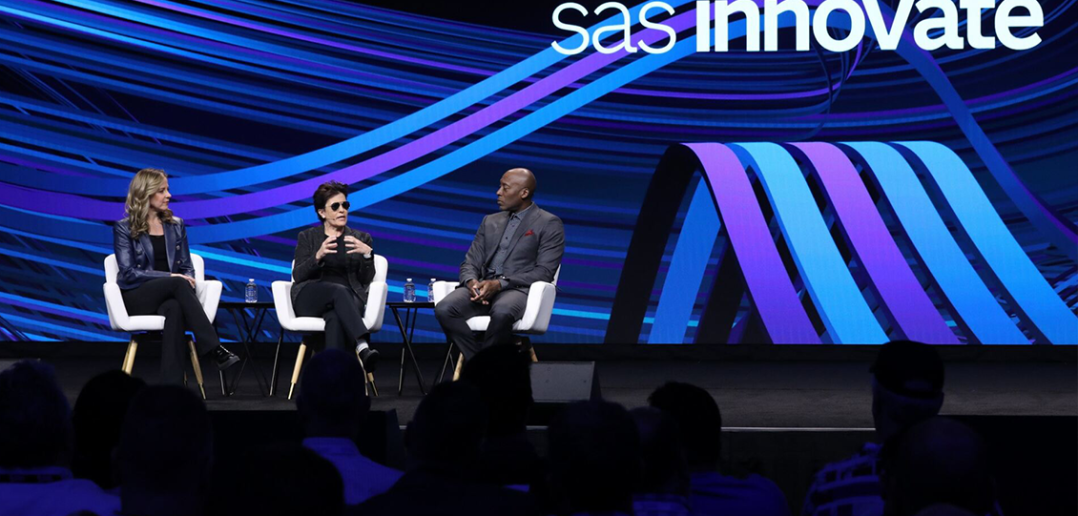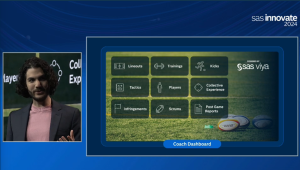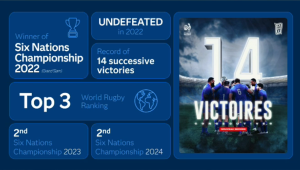Have you ever heard the saying, “Products that don’t perform won’t be trusted, and products that can’t be trusted aren’t worth the machines they’re coded on”? Maybe not, because I just made it up.
But at SAS, as we continue to create products that perform and change the world, we build trust in those products from the very beginning.
Day 1 of SAS Innovate was a deep dive into our products and how we are showing up in the market. On day 2, performance and trust graced center stage.
Vegas models? Give me SAS Models
Host Dominique Weatherspoon cracked this joke in her opening. When it comes to models, businesses should be excited to work with SAS. In 2024, SAS announced the AI and Applied Models division within R&D, specifically focused on creating models to be offered as products.
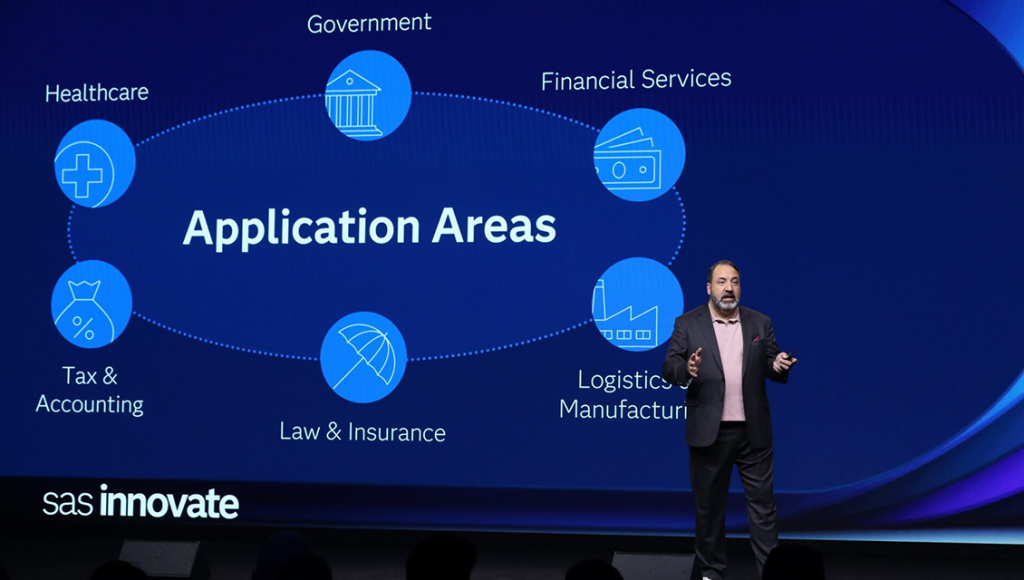
The Vice President of the newly minted division, Udo Sglavo, was preceded on stage by various "SAS Models", i.e., employees quite literally modeling Viya-branded clothing. Following this elaborate pomp and circumstance, a joy for the audience to behold, Sglavo pointed to SAS’ investment in businesses that are builders of AI, buyers of solutions, and models.
Attendees learned how SAS is developing lightweight models as products that can be operationalized by and targeted to specific industry concerns while allowing businesses to overcome the data science talent gap.
Banking is one of the four specific industries targeted at SAS, along with insurance, public sector and life sciences. To illustrate how a customer model could be packaged as a product, Sglavo used an example of a SAS customer, a UK-based bank attempting to improve customer experience and better identify fraud.
An area that is ripe for SAS is productizing models built on SAS’ core assets, talent, and IP, as demonstrated by its wealth of experience working with customers to solve industry problems.
— Chandana Gopal, Research Director, Future of Intelligence, IDC
With the power of SAS, the bank was able to increase approval rates, decrease false positives (possible fraudulent transactions that were legitimate), and detect fraud more accurately.
Through this example, SAS Models as products were formally announced to the audience. And of course, met with roaring applause. With that, SAS will be able to bring AI to the masses and commercialize the technology with unique industry insights.
“This is the future of data and AI, and we are all in,” Sglavo said to end his segment.
"You want to be fast"
“Performance has a tremendous impact on productivity,” Jared Peterson, SAS Sr. Vice President of R&D Platform Engineering, said to open this segment. “You want to be fast, you have to have the ability to scale, and of course, we always want to reduce our cloud costs. This is [how we measure]performance.”
The number and sheer magnitude of decisions facing businesses today are only increasing, and the speed at which these decisions are made is ultimately dependent on the tools employed. Fast decisions are necessary to capitalize on opportunities, and if you miss an opportunity because your software wasn’t fast enough, the competition wins. Businesses must also be agile and adaptable to changing data sets and customer bases.
Lastly, speed and scalability at the expense of cost, where funds determine the availability of trustworthy technology, is a lose-lose for both SAS and our customers.
To demonstrate the performance of SAS® Viya®, Peterson welcomed Senior Systems Engineer Sahbi Chaieb to discuss SAS’ partnership with the French Rugby team.
Sports teams are judged by their performance on the field of play – and for the French Rugby team prior to teaming up with SAS, the performance hadn’t been great. From 2011-2019, the team’s overall winning percentage was médiocre at .411. In the five years since applying SAS Viya to its arsenal, the team’s winning percentage is now .760 since 2019, including a Six Nations Championship in 2022 and a Top 3 World Rugby Ranking. Magnifique.
- L: Sahbi Chaieb discussing the breadth of data provided to French Rugby coaching staff with SAS Viya.
- R: Recent successes of the French National Rugby team.
“This is where the power of SAS Viya comes into play,” said Peterson.
After this presentation, Peterson welcomed SAS Director of R&D Compute and Data Services Wes Gelpi to demo SAS Viya Workload Manager, a product geared to “get the most out of cloud computing,” to the tune of 65% faster job execution and 47% cost savings with autoscaling and high-performance batch updates – a game changer for customers.
Lastly, Peterson was joined by SingleStore CEO Raj Verma to talk about their partnership with SAS.

“Partnerships start with a promise of what we can accomplish from a technological standpoint,” Verma said. “With SingleStore and SAS, you get something that is unmatched in the market. We (SingleStore) are, empirically, the fastest database in the world. When you marry that with SAS, it’s an unbeatable combination."
To demonstrate this partnership, Peterson showed how Posten, a Norwegian postal and freight service, has been able to increase its performance. Data queries are returning over 100x faster. Posten has data joining tables in the database 100x faster. These tables are being read 4x faster. And finally, batch jobs are running 5x faster. A complete transformation of how mail and packages are delivered and received in the country of Norway.
With SingleStore and SAS, you get something that is unmatched in the market. We [SingleStore] are, empirically, the fastest database in the world. When you marry that with SAS, it’s an unbeatable combination.
—Raj Verma
To close out, Peterson’s segue into the next segment sounded like this: “All this performance means nothing, at the end of the day, on its own – you can be as productive as you want, you can be as fast as you want, but if you end up in the wrong place, does it really matter? You have to be able to go beyond the math. A productive and performant stack has to be met with trusted results.”
Let's talk about trust
Being a company with a reputation for trusted analytics is one thing, but what does that mean? We’ve been around for nearly 50 years, but longevity isn’t the only reason customers trust SAS. It’s because responsibility and trustworthiness are built into our products before the first line of code is written.
Reggie Townsend is one of the symbols of trust at SAS. As SAS' Vice President of the Data Ethics Practice, he and his team work to prevent and solve problems created by technology.
“The reality is, some problems we create, and some problems we inherited, Townsend said. “For example, AI has both created and inherited problems. With new innovations, old disparities are often perpetuated. We can either try to mitigate the harms or perpetuate them.”

Townsend described how distrust is at the heart of all the issues associated with AI: “People have a hard time believing AI will improve their safety, understand their needs or benefit them.
In a world where AI is the ultimate tech buzzword of the day, companies the continuing to speedily embrace AI and integrate it into their products. At SAS, while we are doing the same, we are doing so responsibly and ethically. As Townsend puts it, in addition to products and services, “We (SAS) need to be trading on trust. We are competing on our values, which are integrated into our technology – and we are establishing ourselves as a leading voice in this space and as a market leader in data and AI.”
Ultimately, our customers are able to be trustworthy when they partner with SAS. Our products and performance, as Peterson said, mean very little if our company or our products can’t be trusted. To address that, Townsend announced SAS' new AI Governance Group, designed to provide oversight, operations support, compliance regulations and culture norms for businesses interested in having trustworthy results.
A deep dive into trustworthy AI
Townsend was then joined on stage by renowned journalist and author Kara Swisher, and President and CEO of EqualAI, Miriam Vogel. The three had a spirited conversation about “getting AI right” as Townsend set it up. Specifically, how AI should be regulated, overseen and equally dispersed to and for all people, regardless of background.
“The opposite of diversity is homogeneity. The opposite of equity is unfairness. The opposite of inclusion is exclusion,” Swisher said to set up this important point. “Our country (speaking specifically about the United States) is built on the vast landscape of people, and the same thing should happen with AI – a small group of people shouldn’t be making decisions for the vast majority of people.”
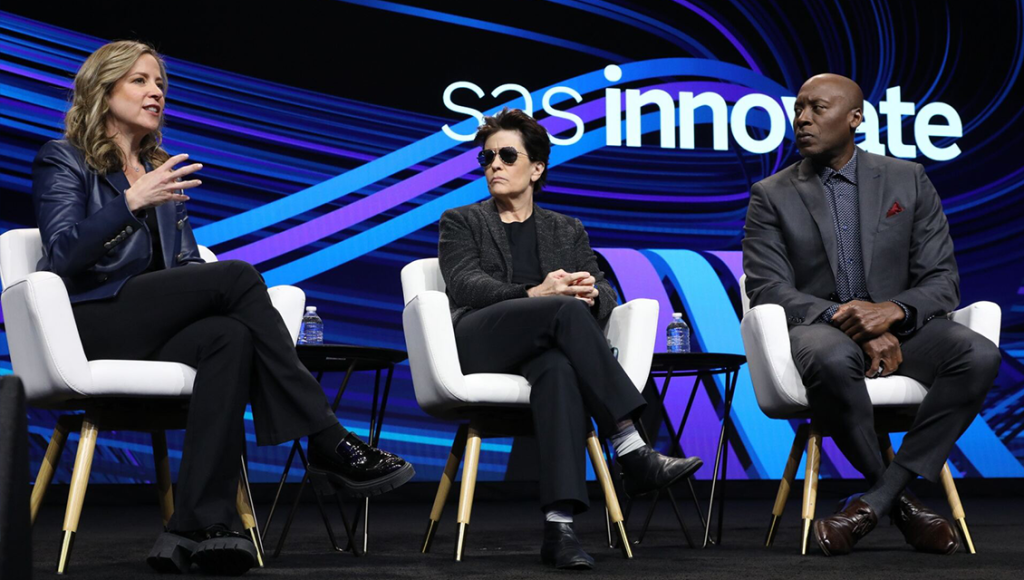
Vogel echoed in agreement, “[You get] better outcomes. It’s not just the right thing to do. All the data demonstrates that you get better products if you have a more diverse group.”
Near the end of the conversation, Swisher related to a point that Townsend had addressed in an earlier segment: that though we may not have “built the house,” so to speak, this is the house that we have (speaking about AI, in this case). “What are you going to do moving forward,” Swisher said. “Stop complaining about the freaking house, what are you going to do to make it better?”
